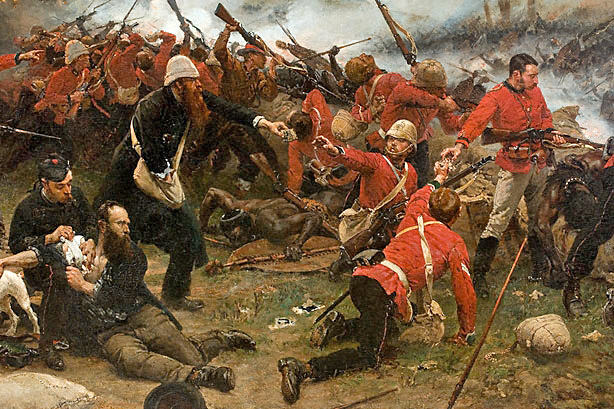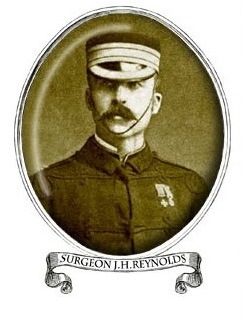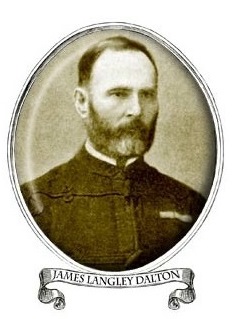Background
In 1789 at Rorke’s Drift, Natal Province, South Africa, eleven Victoria Crosses were awarded, the most for any single

Surgeon Reynolds tends to the wounded while an Assistant Commissary distributes ammunition during the defence of Rorke’s Drift
engagement. Seven to the 2nd Battalion, 24th (2nd Warwickshire) Regiment of Foot, one to the Army Medical Department (which became the Royal Army Medical Corps) , one to the Royal Engineers, one to the Commissariat and Transport Department (which became the Royal Army Service Corps and later the Royal Logistics Corps) and one to the Natal Native Contingent. In addition there were Distinguished Conduct Medals awarded
Upon occupying Ashton Armoury 11 (Victoria) Service Battalion (now 11 Services Company 39 Service Battalion), and 11 (Victoria) Medical Company, (now 11 (Victoria) Field Ambulance) adopted Rorke’s Drift as a bonding link to their respective pasts albeit vicariously through their affiliated British Army corps. In respect of that common bond a Zulu Warrior in full regalia, on loan from the Royal British Columbia Museum, is on display in the Armoury Officers’ Mess which until recently held an annual Rorke’s Drift Mess Dinner.
Click here to learn more about the defence of Rorke’s Drift
Notable Defenders
Victoria Cross
James Henry Reynolds, V.C. (Army Medical Department, later Royal Army Medical Corps)
Why he was awarded the Victoria Cross
Under heavy fire he both attended the wounded and brought ammunition to the hospitals defenders. He was 34 at the time of the defence
Further Information
James Henry Reynolds was born in Dublin on February 3rd 1884. Educated at Castleknock School Dublin, he obtained his Bachelor of Medicine and Bachelor of Surgery from Trinity College Dublin in 1867 before joining the Army Medical Department in March 1868. He served with the 36th Foot in India during 1869-1870 but was invalided home after a serious outbreak of cholera hit the regiment.
He arrived in South Africa in August 1874 and later accompanied the 1/24th on their minor expedition to the Diamond Fields in 1875. He served alongside both the 1/24th and 88th Regiments during the Eastern Frontier Campaigns of 1877 – 1878 and was present at the action around Mpetu in January 1878. By January 1879 he found himself in charge of the field hospital at Rorke’s Drift where he remained looking after the sick for some weeks afterward. After the action he was promoted to Surgeon-Major and was present in the British camp at Fort Nolela for the final battle at Ulundi in July 1879. He received the V.C. from Colonel R.T. Glyn during a special parade of the 1/24th at Pinetown Camp outside Durbin on Tuesday 26th August 1879.
Upon his return to Ireland he was appointed Senior Medical Officer for the expédition to aid Captain Charles Boycott during the so called Irish Land War of 1880.
He retired from the army after 27 years’ service with the rank of Brigade Surgeon Lieutenant Colonel in 1896.
He attended a special dinner to honour holders of the Victoria Cross at the House of Lords in November 1929. He died, aged 88 years, at the Empire Nursing Home, London, and is buried at St Mary’s Roman Catholic Cemetery. His Victoria Cross, South African campaign medal and Gold Medal of the British Medical Association are currently on loan to the Army Medical Services Museum, Keogh Barracks, Ash Vale, Aldershot, Hampshire, England.
James Langley Dalton, V.C. (Commissariat and Transportation Department, the  Commissariat Corps and the Royal Corps of Transport)
Commissariat Corps and the Royal Corps of Transport)
Why he was awarded the Victoria Cross
Superintended the work of defence and was among those receiving the first wave of the attack where he saved a man’s life by killing his Zulu assailant. Although wounded himself he continued to give the same display of cool courage throughout the action. He was 46 at the time of the defence.
Further Information
James Dalton was born in London in 1833. He enlisted in the 87th Foot in November 1849 age 17. He transferred to the Commissariat Corps in 1862 as a Corporal and was promoted to Sergeant in the following year. Four years later he became a clerk and Master Sergeant. He served with Sir Grant Wolseley on the Red River Expedition (Canada) in 1870.
He retired from the army with a Long Service & Good Conduct medal in 1871 after 22 years’ service. By 1872 he was in South Africa and volunteered for service as Acting Assistant Commissary with the British Forces. It was largely due to his experience that made the defence of Rorke’s Drift a success. His contributions initially went unrecognized, however, reports of his actions eventually reached the ears of senior officers and even Queen Victoria.
He received his Victoria Cross from General Hugh Clifford V.C. at a special parade at Fort Napier on 16 January 1880. He returned to army service being given a permanent commission. He sailed to England in 1880 but soon returned to South Africa and took part shares in a gold mine. He died suddenly on 7 January 1887 in Port Elizabeth, Eastern Cape and is buried in the Russell Road Roman Catholic Cemetery Port Elizabeth. His Victoria Cross is in the Royal Logistics Corps Museum, Blackdown, Camberley, Surrey, England.
Distinguished Conduct Medal (D.C.M)
Second Corporal Francis Attwood, D.C.M (Army Service Corps)
NOTES:
- On 15 January 1880, a submission for a DCM was also made for Private Michael McMahon (Army Hospital Corps). The submission was cancelled on 29 January 1880 for absence without leave and theft.
- The DCM was at the time, for all ranks below commissioned officers, the second highest award for gallantry in action after the Victoria Cross,

